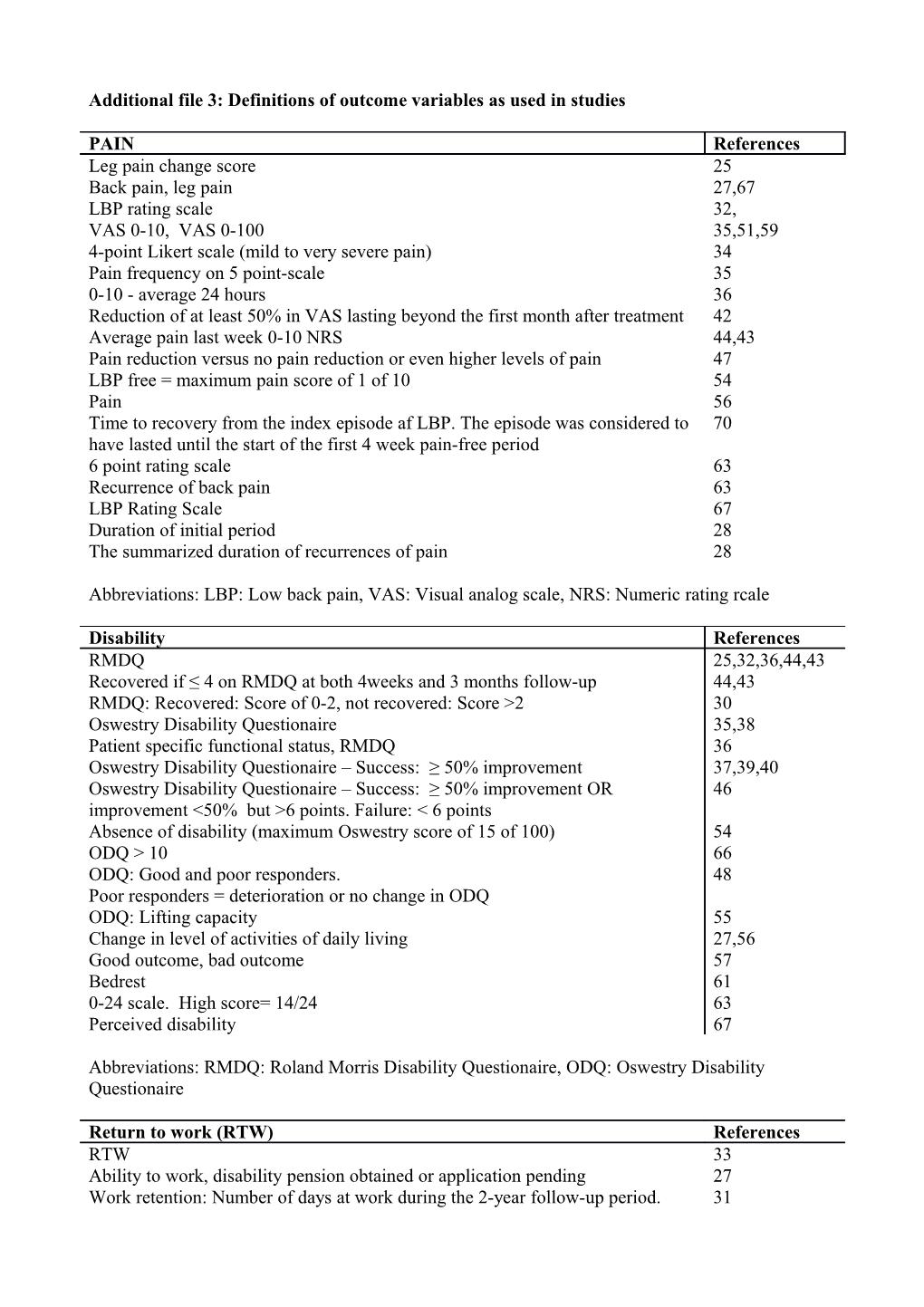Additional file 3: Definitions of outcome variables as used in studies
PAIN / ReferencesLeg pain change score / 25
Back pain, leg pain / 27,67
LBP rating scale / 32,
VAS 0-10, VAS 0-100 / 35,51,59
4-point Likert scale (mild to very severe pain) / 34
Pain frequency on 5 point-scale / 35
0-10 - average 24 hours / 36
Reduction of at least 50% in VAS lasting beyond the first month after treatment / 42
Average pain last week 0-10 NRS / 44,43
Pain reduction versus no pain reduction or even higher levels of pain / 47
LBP free = maximum pain score of 1 of 10 / 54
Pain / 56
Time to recovery from the index episode af LBP. The episode was considered to have lasted until the start of the first 4 week pain-free period / 70
6 point rating scale / 63
Recurrence of back pain / 63
LBP Rating Scale / 67
Duration of initial period / 28
The summarized duration of recurrences of pain / 28
Abbreviations: LBP: Low back pain, VAS: Visual analog scale, NRS: Numeric rating rcale
Disability / ReferencesRMDQ / 25,32,36,44,43
Recovered if ≤ 4 on RMDQ at both 4weeks and 3 months follow-up / 44,43
RMDQ: Recovered: Score of 0-2, not recovered: Score >2 / 30
Oswestry Disability Questionaire / 35,38
Patient specific functional status, RMDQ / 36
Oswestry Disability Questionaire – Success: ≥ 50% improvement / 37,39,40
Oswestry Disability Questionaire – Success: ≥ 50% improvement OR improvement <50% but >6 points. Failure: < 6 points / 46
Absence of disability (maximum Oswestry score of 15 of 100) / 54
ODQ > 10 / 66
ODQ: Good and poor responders.
Poor responders = deterioration or no change in ODQ / 48
ODQ: Lifting capacity / 55
Change in level of activities of daily living / 27,56
Good outcome, bad outcome / 57
Bedrest / 61
0-24 scale. High score= 14/24 / 63
Perceived disability / 67
Abbreviations: RMDQ: Roland Morris Disability Questionaire, ODQ: Oswestry Disability Questionaire
Return to work (RTW) / ReferencesRTW / 33
Ability to work, disability pension obtained or application pending / 27
Work retention: Number of days at work during the 2-year follow-up period. Failure = 3 days off in a row due to LBP or 5 days within a 12 months period / 31
Receiving no social transfer payments other than unemployment payment in the 52nd week after inclusion – register based / 32
Time to return to regular work without restrictions / 41
Sickness absence / 43,64
Back-to-work vs not working / 47,60
Returners (returned to work) and non-returners
(remained on sick-leave) / 49
RTW and the duration of time off work between beginning of treatment and RTW / 50
Returned in any capacity / 52
RTW: Improvement in actual work activity. Non-return: Patients without improvement and patients on vocational measures / 53
Working or not / 55,64
Cumulative number of days a claimant received benefits for one year from the date of the accident / 58
Complete RTW(100%); incomplete RTW(<100%) / 71
Success: RTW or work status improvement
(within 12 weeks considered treatment related) / 73
Days absent from work. Time period not described / 63,67
Recurrences. Chronicity ³ 25% of days during one year on sick leave / 66
Duration of sick-leave during the initial episode / 28
Number of sick leave days since last questionaire / 65
Number of new sick leave periods / 66
Total absence from work owing to recurrences / 28
RTW: ”Success group”: Completed program and back to work at one year FU. ”Failure” group: Completed program but not back to work. Drop-out group: Dropped out of the program before completing
”Failed to enter” group: Did not enter after initial evaluation. / 62
Use of Health Care services and medication / References
Medical resources used (8 different measures) / 41
Use of health care and use of medication / 43
Medication / 61
Use of provider / 56
Radical treatment (nucleolysis or discectomy) if inadequate response to at least two months of conservative care / 69
Surgery, medication / 67
Global Improvement / References
Global improvement based on patient’s and clinician’s opinion / 26
Self rated overall assessment / 27
Patients rating of back situation as much worse, worse, unchanged, better, or much better / 36
Worsened, unchanged, improved, improved greatly. Major improvement after 2 weeks defined as major improvement as reported by the patient. Poor outcome after 3 months was defined as absence of improvement or eventual surgery. / 72
Somatic and depressive distress (Zung + Medicare secondary payer questionaire + combining) / 35
Patients subjective rating of success / 47
Patients subjective opinion of efficacy / 68
Combination outcome / References
Symptom free and improving (both composite pain and disability) / 29
Complicated versus light course
Complicated defined as being on sick leave for 30 days or use of pain medication > 99 days or being bedridden for > 10 days / 61
Three categories - Poor outcome: On sick leave between questionaires or not functionally recovered at follow up. Fair outcome: Functionally but not completely recovered (able to do ordinary daily activities but not well-being with regard to LBP) with no sick leave at any time between questionaires. Good outcome: No indication of LBP at any time between questionaires / 65
Recovery = no pain (VAS) or disability (RMDQ) / 33
Recovered if Pain = 0 (VAS 0-10 cm) and disability score < 4 (RMDQ) / 45
